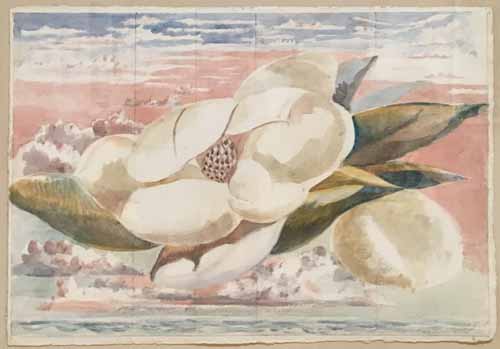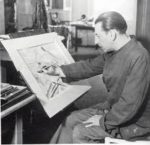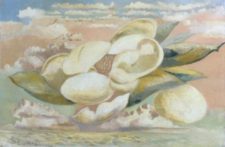
Paul Nash
British, 1889–1946
Flight of the Magnolia, 1944
pencil, pen and ink, charcoal and watercolor on paper
10 3/4 x 15 1/4 in.
SBMA, Gift of Wright Ludington
1947 1947.13.5

Paul Nash was a painter, surrealist and war artist, as well as a book-illustrator, writer and designer of applied art. He was the older brother of the artist John Nash.
"I am a messenger who will bring back word from the men who are fighting (WWI) to those who want the war to go on forever. Feeble, inarticulate will be my message, but it will have a bitter truth and may it burn their lousy souls." - Paul Nash

Flight of the Magnolia, 1944, Oil paint on canvas, Tate Acquisition Purchased with assistance from the Friends of the Tate Gallery, the Art Fund and a group of donors 1999.
COMMENTS
The Awareness of life-forces and the sense of their mystery implied in works of Nash’s youth like “Spring Woods” evolved later into a conscious attempt to objectivity them in his maturity. The two 1944 watercolors, painted during the last years of his life, give visual expression (as do many other works of the 1940’s) to his ideas, partly formulated in his essay “Aerial Flower”. In a contemporary letter, Nash wrote, “I am trying to pursue a certain imaginative ‘idea’ which is beyond the formal structure of the pictures”. Elsewhere he described “the idea behind the design (as)the mystical association of two objects which inhabit different elements and have no apparent relation to life… No legend or history attaches to such a picture; its drama is inherent in the scene. Its appeal is purely evocatory. That is to say, its power, if power it has, is to call up memories and stir emotions in the spectator, rather than to impose a particular idea upon him.”
On the fringe of the tradition of Western European mysticism with evident relation to such expressionists as Nolde, these watercolors manifest a kind of romantic surrealism, in their use of such characteristic devices as metamorphosis, (e.g., magnolia as cloud), irrational and dreamlike juxtaposition (e.g.flight itself, and the flower and moon) and perhaps some anthropomorphism (e.g. the slightly intimidating scale and the organic forms of the magnolia). However, despite the artist’s ambiguity, they seem equally derivative from the literature of poetic fantasy; Bertam has pointed out the correspondence to Wordsworth’s line in “Ruth”:
He told of the magnolia, spread
High as a cloud, high over head.
- From the SBMA files
Summary from The Tate
Flight of the Magnolia is part of a group of late works by Paul Nash that feature what the artist called ‘aerial flowers’. The painting depicts an unfurling magnolia blossom in flight, suspended between clouds and sea. Both the fleshy folds of the magnolia’s rounded petals and the seascape behind are realised in a pastel palette of pinks and blues, creating the impression of delicate dawn light. Nash made three versions of the painting during the summer of 1944, when he was living in Oxford, producing two near-identical watercolours on paper (now in the collections of the Victoria and Albert Museum in London and the Santa Barbara Museum of Art in California) before working up this larger, final version in thickly applied oil paint.
Elements of this scene may be traced to a trip that Nash made in September 1943 to Dorset with his close friend Lance Sieveking, a British writer and BBC producer. During this visit, Nash made a quick study of a magnolia flower given to him by another friend, Gillian Barnard. ‘For months’, Nash later wrote in a letter to Barnard, the drawing remained just another study yet I felt quite certain it had a more important destiny. Then just recently I arrived at my ‘aerial flowers’ series … the magnolia became air borne & it took to the element as a duck to water ... If you like the picture, feel you helped to make it or indeed caused it.
- Pennie Denton, ‘Paul Nash and the Blue Pool’, Dorset Life – The Dorset Magazine, May 2013, pp. 46–7.
In his own recollections of the trip, Sieveking links Flight of the Magnolia to an unusual cloud formation that he and Nash glimpsed on their last morning in Dorset (Sieveking 1957, pp.79–83).
Despite these connections, the setting of Flight of the Magnolia is left undefined. In this respect, the painting differs from much of Nash’s previous work, which explores the character of specific landscapes. Rather than pursuing this tendency, Flight of the Magnolia’s vision of a flower in the sky brings Nash’s early interest in the mystical qualities of paintings by Samuel Palmer and William Blake – evident in works such as The Pyramids in the Sea 1912 (Tate T01821) – to bear on his longstanding fascination with flight and the sky. These subjects gained new emphasis for the artist during the late 1930s, as military attacks from the air became an increasing threat. In an essay from 1945, named after his ‘aerial flowers’ series, Nash describes how the Second World War affected his perception of the sky:
When the war came, suddenly the sky was upon us all like a huge hawk, hovering, threatening. Everyone was searching the sky, expecting the terror to fall: I among them scanned the low clouds … hunting the sky for what I most dreaded in my imagining. It was a white flower. Ever since the Spanish Civil War the idea of the Rose of Death, the name the Spaniards gave to the parachute, had haunted my mind, so that when the war overtook us I strained my eyes always to see that dreadful miracle of the sky blossoming with these floating flowers. (Nash 1945, pp.158–9.)
While the flower in Flight of the Magnolia may be seen to relate to this vision, Nash also suggests in the same essay that his sky-bound flowers serve as ‘equivalents’ for his imaginative activity more generally (Nash 1945, pp.160–1). At the end of the essay, he addresses his experiments with airborne flowers in light of his own mortality: ‘it is death I have been writing about all this time … death, I believe, is the only solution to this problem of how to be able to fly’ (Nash 1945, pp.160–1). Many writers on Nash have highlighted this conclusion when interpreting Flight of the Magnolia, which was painted when the artist’s health was in decline, and just two years before his death. For example, Nash’s first biographer, Anthony Bertram, describes the image as ‘the last flight of the soul … in the form of a flower’ (Bertram 1955, pp.296–7).
The mysterious image in Nash’s painting provided the basis for a recent 16mm film, Our Magnolia 2009, by the British artists Rosalind Nashashibi and Lucy Skaer, which begins and ends with two extended shots of the canvas.
Further reading
Paul Nash, ‘Aerial Flowers’, Counterpoint, no.1, 1945, pp.1–8, reprinted in Andrew Causey (ed.), Paul Nash: Writings on Art, Oxford 2000, pp.135–61.
Anthony Bertram, Paul Nash: The Portrait of An Artist, London 1955, pp.296–7.
Andrew Causey, Paul Nash, Oxford 1980, p.320.
- Debra Lennard, January 2014
SBMA CURATORIAL LABELS
Nash served as an Official War Artist in both World Wars. During the 1940s, although attached to the Royal Air Force, ill health precluded him from flying, but he was obsessed by the idea of flight. In addition to his masterpiece The Battle of Britain (Collection Imperial War Museum, London) he created a series of surreal images in watercolor of flowers in flight.
- British Modernism from Whistler to WWII, 2016
In 1940 Nash was attached to the Air Ministry as an official war artist, but because of his acute asthma, a legacy from his time in the trenches during World War I, he was not permitted to fly. Despite lack of first-hand experience, he allowed his imagination to take wing, with surprising results. Over the next two years he produced not only such masterpieces as Battle of Britain and Battle of Germany (both in the Imperial War Museum, London) but also a series of watercolors of anthropomorphic bombers – “aerial creature” as he called them. This stimulated a further series of dream-related images and he wrote to a friend saying he was “doing some strange new pictures. Giant flower blooming among the clouds or sailing down the night skies like falling stars.” Flight of the Magnolia is one of the most exuberant examples from this group.
- SBMA label from past exhibitions
